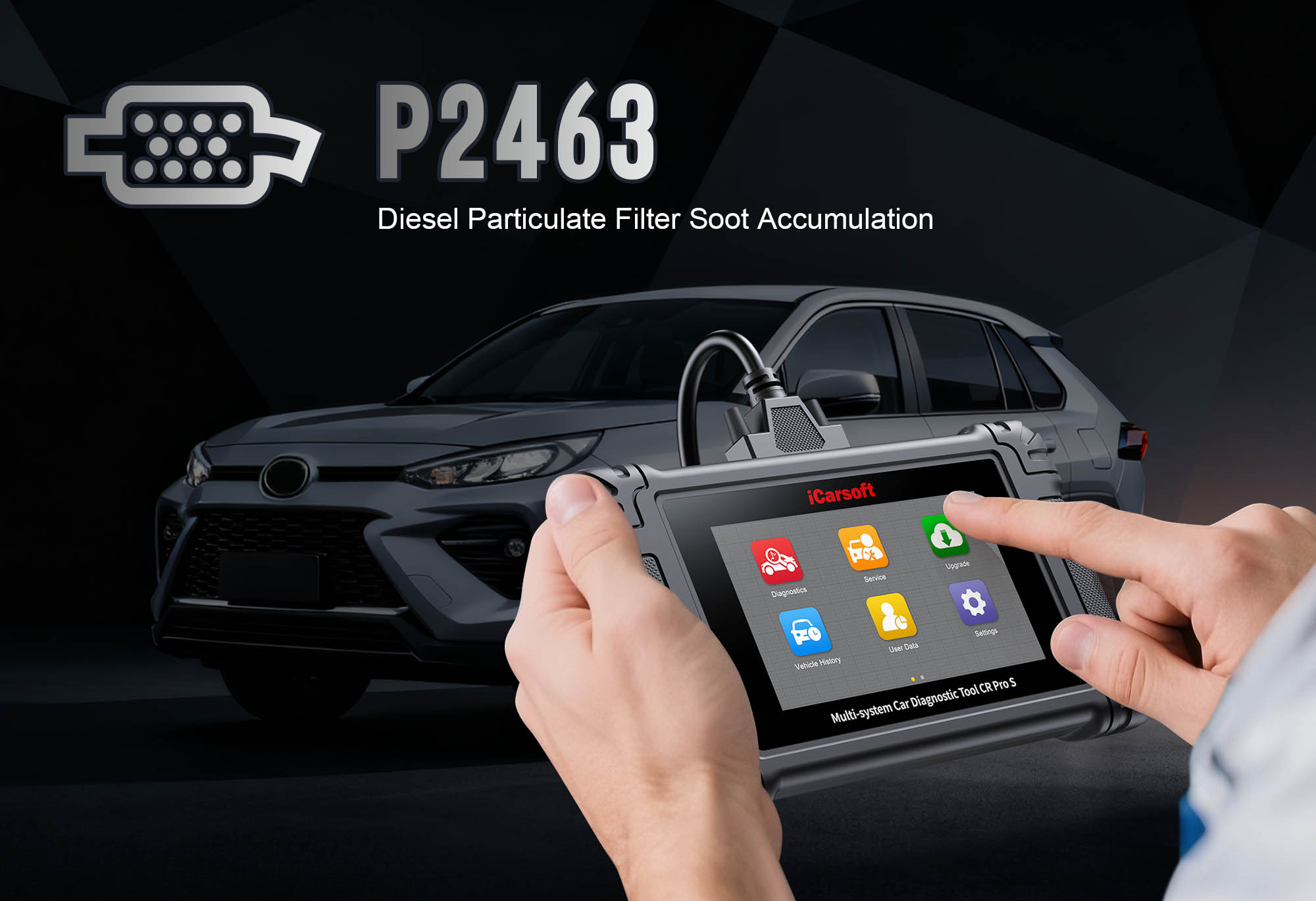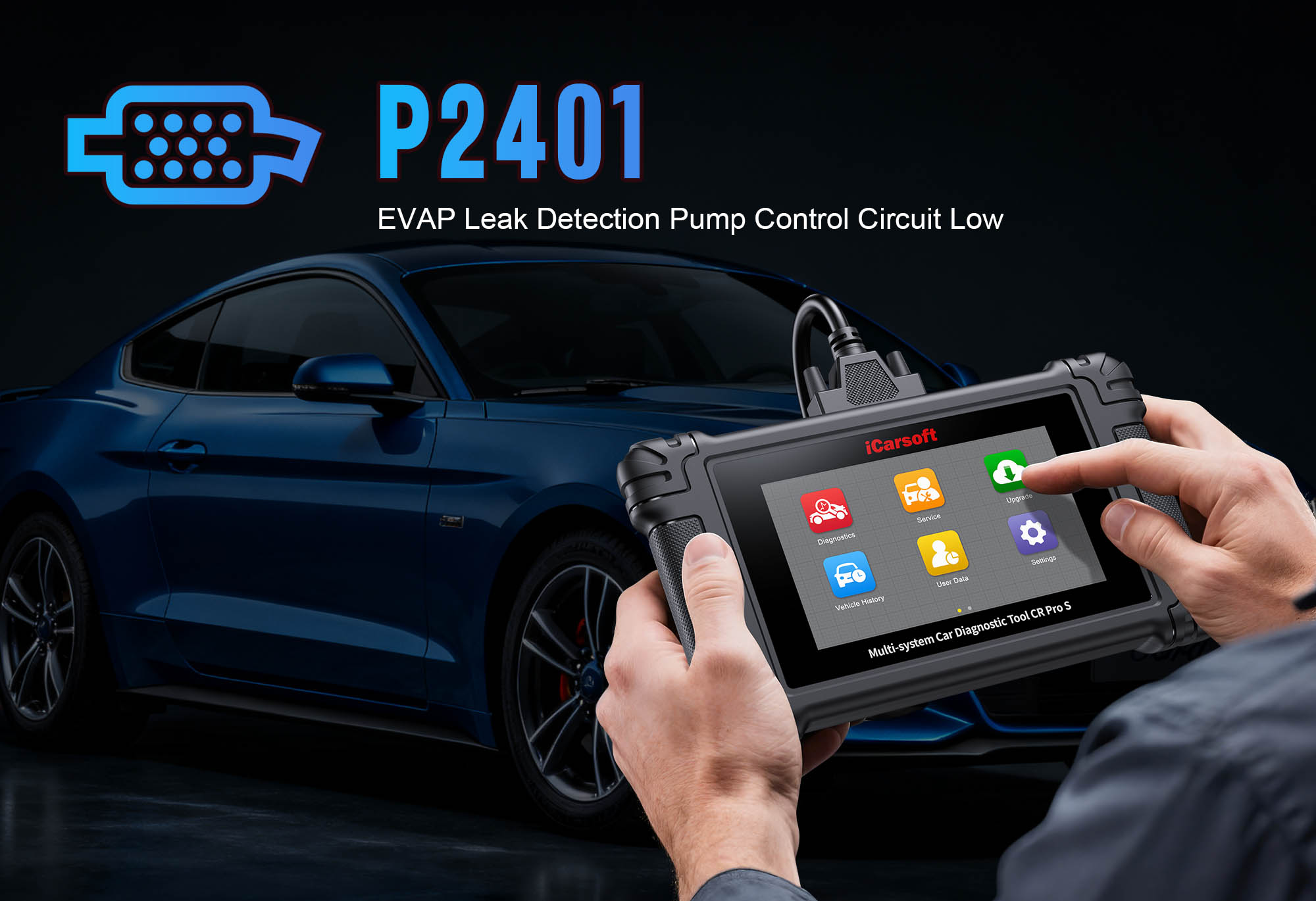Understand P2463: DPF Ash Accumulation - Fix with iCarsoft CR Pro S
If you own a diesel vehicle and notice the Check Engine Light (CEL) paired with reduced power or increased exhaust smoke, a diagnostic scan will likely return P2463. This critical OBD-II code stands for "Diesel Particulate Filter (DPF) Ash Accumulation"—a common issue in diesel engines relying on the DPF to trap soot and reduce emissions. Unlike soot (burned off via regeneration), ash is a non-combustible byproduct of engine oil additives. Its buildup clogs the DPF over time, disrupting performance and emissions compliance.
Basic scanners only label this a "DPF fault" but can’t distinguish between ash accumulation, soot clogging, or sensor failure. This leads to unnecessary $1,500+ DPF replacements when cleaning suffices. The iCarsoft CR Pro S eliminates guesswork with OE-level DPF diagnostics, ash load monitoring, and regeneration controls—ideal for fixing P2463 in Ford Power Stroke, Chevrolet Duramax, Ram Cummins, and more. Below, we break down causes, symptoms, step-by-step fixes, and 8 FAQs.
What Exactly Is P2463?
P2463 targets excessive ash accumulation in the DPF. The DPF traps exhaust particulate matter (soot), while regeneration burns soot at high temperatures. Ash—formed by burned oil additives leaving mineral deposits—cannot be burned off. Over 100,000–150,000 miles, ash builds up, restricting exhaust flow. The ECM monitors DPF pressure and ash load via sensors; when ash exceeds 10–15% of DPF capacity (manufacturer limit), it logs P2463.
This code is prevalent in heavy-duty diesel trucks (Ford F-250 P2463 Power Stroke, Chevrolet Silverado P2463 Duramax) operating under high load, and diesel passenger cars like Volkswagen Touareg TDI.
Key Symptoms of P2463
-
Illuminated Check Engine Light: Primary warning, often paired with "DPF Ash Overload" message in newer models.
-
Reduced Engine Power: Restricted exhaust flow causes acceleration lag—critical for Ram 2500 P2463 towing scenarios.
-
Increased Fuel Consumption: Engine compensates for backpressure, leading to 10–20% lower MPG (common in high-mileage P2463 diesel).
-
Exhaust Smoke: Black/gray smoke from tailpipe, due to incomplete combustion from restricted exhaust.
-
Regeneration Failures: ECM attempts frequent regeneration (increased idle speed) that fails to resolve the issue.
-
Emissions Test Failure: Guaranteed fail, as ash-clogged DPFs emit excessive particulate matter—key for California P2463 smog check.
Common Causes of P2463
|
Cause
|
Description
|
|
Normal Wear & Tear
|
Ash accumulates gradually over 100,000+ miles—unavoidable in diesel engines (top cause in VW Touareg P2463 TDI).
|
|
Excessive Oil Consumption
|
Engines burning oil (worn piston rings/valve seals) introduce more additives, increasing ash production—prevalent in old diesel P2463 oil burn.
|
|
Low-Quality Oil
|
Oil with high metal additive content leaves more ash when burned—avoid cheap diesel oils to prevent this.
|
|
Frequent Short Trips
|
Short drives prevent regeneration temperatures, leading to soot buildup alongside ash, accelerating clogging.
|
|
DPF Cleaning Neglect
|
Skipping scheduled DPF cleanings (every 100,000 miles) allows ash to exceed safe limits.
|
Why iCarsoft CR Pro S Excels at Diagnosing P2463
Resolving P2463 requires accurate ash load measurement and DPF validation—something basic scanners can’t provide. The CR Pro S stands out with diesel-specific features:
Brand-Specific DPF Data
Translates P2463 into model-specific insights (e.g., "Ford Power Stroke: Ash Load 18% (Max 15%); Clean Now" vs. "Chevy Duramax: DPF Pressure 50 psi (Normal 10–20 psi); Ash Clog Confirmed").
Live Ash Load & Pressure Tracking
Monitors real-time ash load percentage and exhaust backpressure, quantifying P2463 severity for targeted fixes.
Forced Regeneration Control
Initiates manual DPF regeneration to burn residual soot—critical for distinguishing ash vs. soot P2463 causes.
DPF Cleaning Validation
Runs pressure/flow tests post-cleaning to confirm ash load is safe—avoids repeat P2463 codes.
Global Diesel Coverage
Supports 50+ diesel brands prone to P2463: Ford, Chevrolet, Ram, Volkswagen, BMW, Mercedes-Benz, and more.
Oil Consumption Monitoring
Tracks oil usage trends to identify excessive consumption—the #1 accelerator of ash buildup.
Step-by-Step: Diagnose & Fix P2463 with iCarsoft CR Pro S
-
Confirm P2463 & Measure Ash Load
Plug the CR Pro S into the OBD-II port, power on, and select AutoVIN Identify to detect diesel make/model/DPF configuration.
Navigate to Engine > Fault Codes > Read Codes to confirm P2463. Tap DPF System > Ash Load to view percentage (e.g., 17% = critical—needs cleaning).
-
Eliminate Soot with Forced Regeneration
Before addressing ash, burn off soot to avoid misdiagnosis. Go to Special Functions > DPF Regeneration and select Forced Regeneration.
Follow prerequisites (engine temp ≥180°F, fuel ≥½ full) and let the process run (10–20 minutes). Recheck ash load—P2463 persisting confirms ash is the root cause.
-
Inspect for Excessive Oil Consumption
1. Use Engine > Live Data > Oil Consumption to review historical usage (if supported).
2. Run Compression Test to check for worn piston rings (common in Duramax P2463 oil issues). Resolve oil burn first to prevent rapid ash reaccumulation.
-
Clean the DPF (DIY or Professional)
1. Ash load 15–20%: Use DPF cleaning kit (chemical/ultrasonic) to flush ash.
2. Ash load >20%: Professional bake-and-blow cleaning recommended.
3. Locate DPF via Component Location tool (under vehicle, near catalytic converter) for easy access.
-
Validate the Fix with DPF Tests
- Clear P2463 via Fault Codes > Clear Codes.
- Run DPF Pressure Test to confirm backpressure is normal.
- Monitor ash load for 500 miles—stable levels (under 10%) = fix successful.
FAQs: P2463 Troubleshooting (Low-Competition Long-Tail Keywords)
Can I drive with P2463, or will it damage my engine?
Short trips are safe, but prolonged driving increases exhaust backpressure, risking turbocharger and catalytic converter damage. Avoid heavy hauling with Ford F-350 P2463—diagnose with the CR Pro S immediately.
How much does it cost to fix P2463?
DIY DPF cleaning = $50–$150 (kit), professional cleaning = $300–$600, new DPF = $1,500–$3,000. The CR Pro S saves $100–$200 on diagnostics and avoids unnecessary replacement.
Why does P2463 return after DPF cleaning?
Excessive oil consumption is unresolved. Use the CR Pro S’s oil consumption monitor to find worn engine parts, and fix oil burn (e.g., replace piston rings) to prevent recurring ash buildup.
Is P2463 the same as P0401 (EGR Flow Insufficient)?
No—P2463 = DPF ash accumulation; P0401 = EGR system issues. The CR Pro S clarifies differences with targeted DPF vs. EGR tests.
Can fuel additives fix P2463?
No—fuel additives only reduce soot, not non-combustible ash. Use the CR Pro S’s regeneration function to eliminate soot, then clean the DPF for ash.
How often should I clean my DPF to prevent P2463?
Every 100,000–150,000 miles (normal use); 75,000 miles (heavy-duty/short-trip driving). Use the CR Pro S’s DPF maintenance reminder to schedule proactively.
Will P2463 affect my diesel vehicle’s warranty?
Yes—unrepaired DPF issues may void emissions warranty. Fix P2463 promptly with the CR Pro S to maintain validity, especially for new Ram Cummins P2463 warranty claims.
Can I prevent P2463 from happening?
Use high-quality low-ash diesel oil, fix oil consumption early, take occasional long trips (trigger natural regeneration), and run monthly DPF checks with the CR Pro S. Avoid short trips under 10 miles for VW TDI P2463 prevention.
Conclusion
P2463’s DPF ash accumulation may seem intimidating, but the iCarsoft CR Pro S simplifies diagnosis with ash load tracking, forced regeneration, and brand-specific data. It ensures you clean (not replace) your DPF, saving thousands while restoring engine performance and emissions compliance.
With its diesel-focused features, lifetime free software updates, and support for 50+ diesel brands, the CR Pro S is a must-have for diesel vehicle owners and mechanics. Resolve P2463, extend your DPF’s lifespan, and keep your diesel running smoothly—all with one professional-grade diagnostic scanner.




